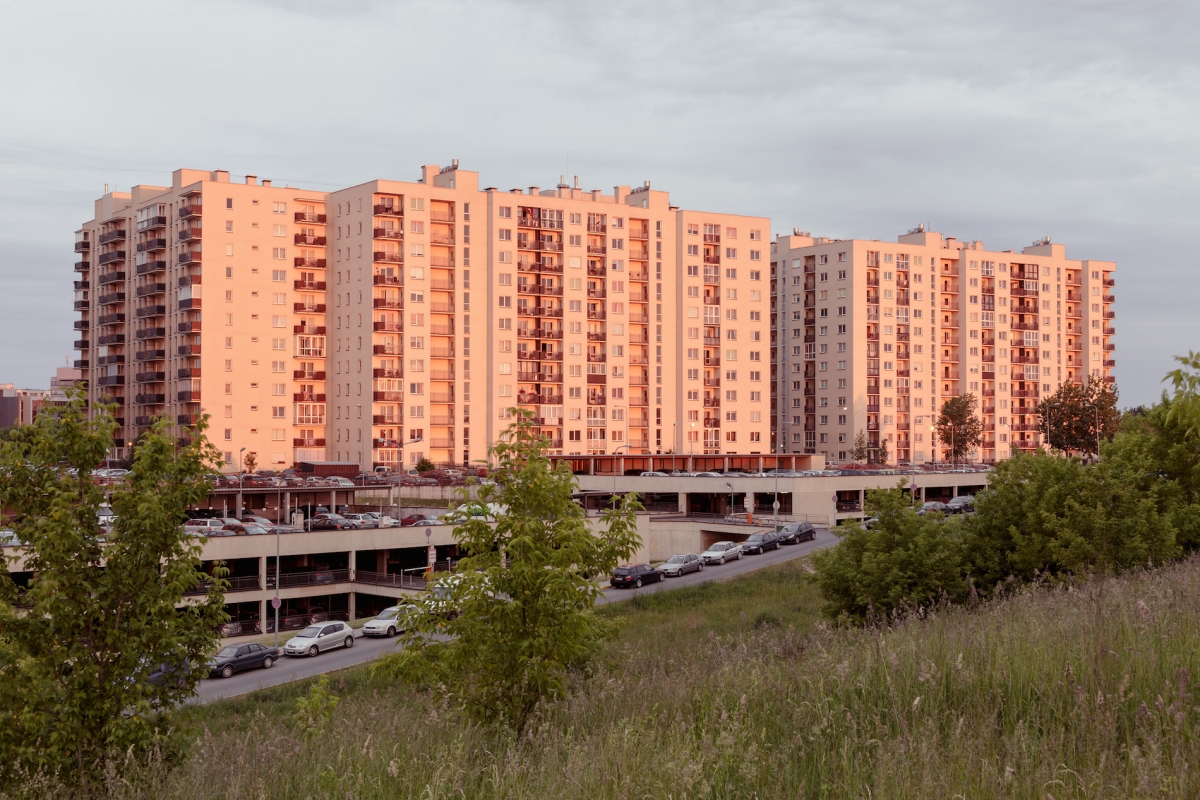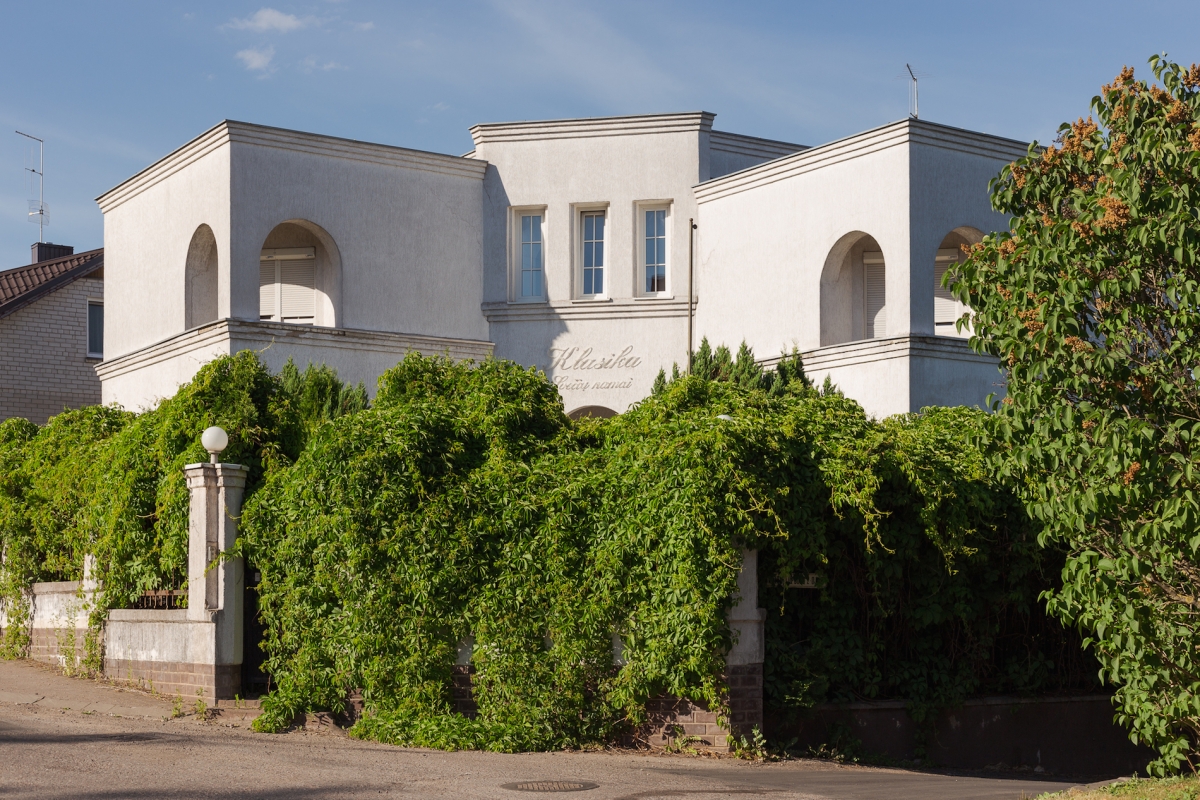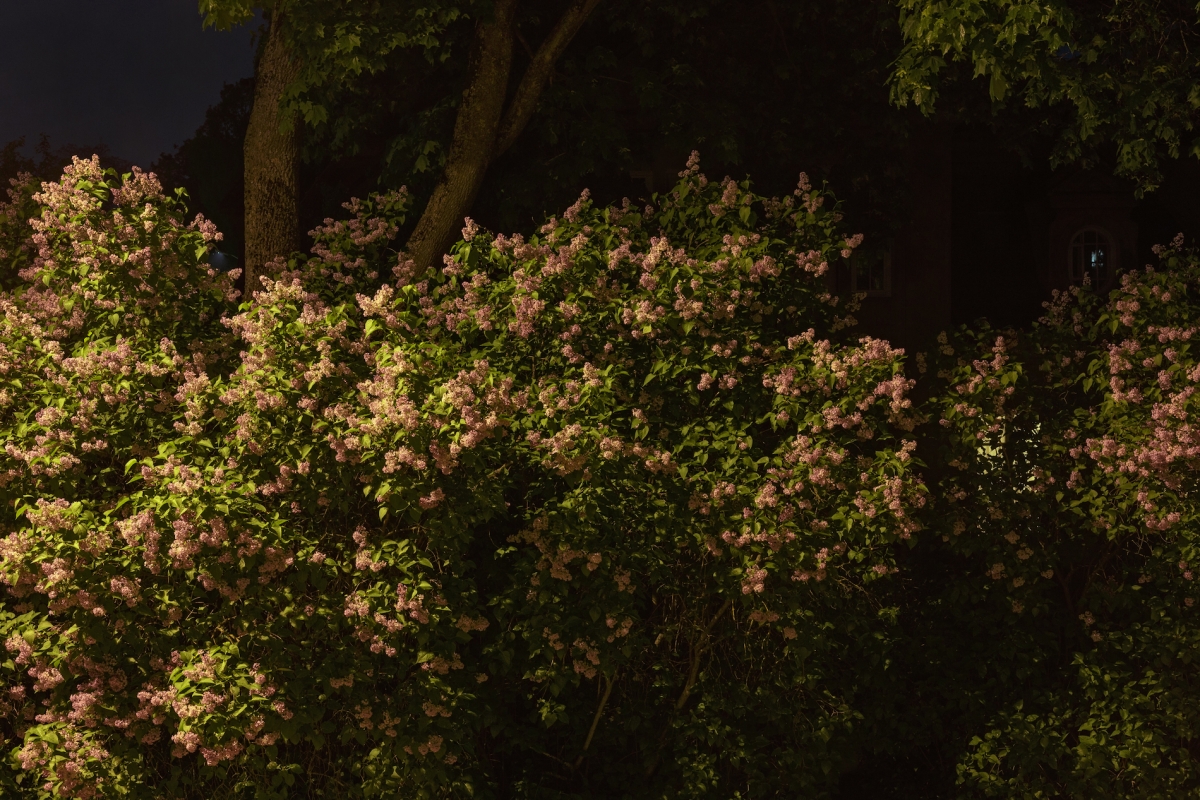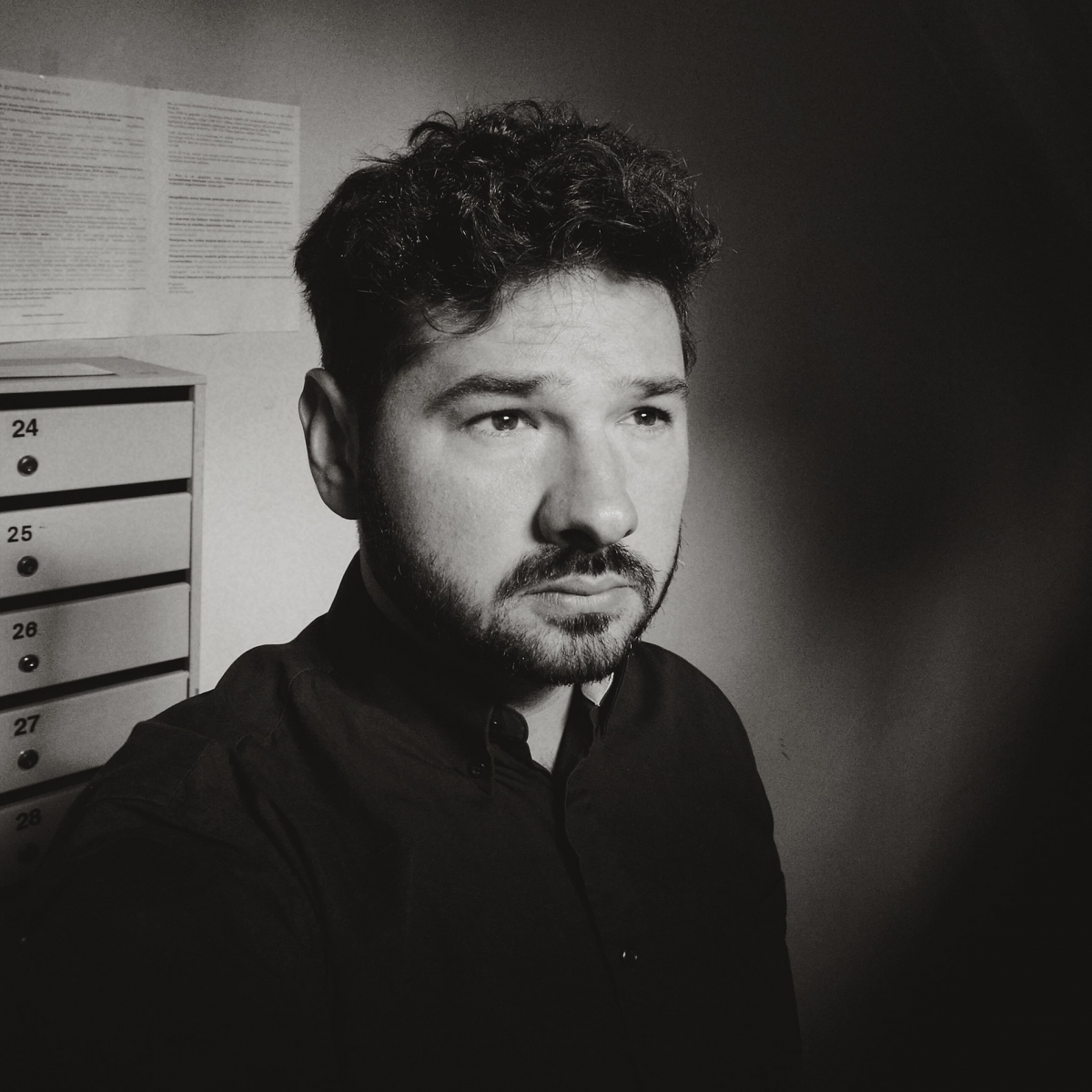The city can be experienced in various ways: thinking, reading, writing about it, or staying there. However, urban structures are best explored by walking and observing them. The artist and photographer Andrej Vasilenko (b. 1985) is also a researcher of the city, exploring all the districts of Vilnius with his camera. He claims that his projects, and especially ‘This is Vilnius’, often raise more questions than answers. Andrej’s projects aim to search for an urban and human identity, to cover cities with details, a cinematic approach and urban variety. Andrej does not try to frame Vilnius in the usual tourist destination images; he is looking for the real city we live in. After this year’s exhibition ‘This is Vilnius’, I interviewed him about projects, Vilnius, photography, contemporary art, and the importance of it all.
‘This is Vilnius’ is a mature project that will soon be celebrating its fifth year. What motives and sources of inspiration led to the project?
The very beginning of the project was during my studies at university. With the help of Professor Artūras Raila, I worked on an interdisciplinary project on the blending of identity and culture that combined various media. I filmed urban spaces, the end of the construction of the Royal Palace, the beginning of the renovation of the Barbican, roughly speaking, projects on the ‘restoration of history’. Later, I photographed a friend’s home, whose family moved from Russia to Lithuania during the Soviet period. Their home was never renovated, and different layers of time existed on top of each other. It was like a museum, with lots of things from the present and the past. These projects have become the starting point for me for topics such as the heritage, identity and the city. I asked where we position ourselves, as residents of Lithuania or Vilnius, what is important to us, and where we are. However, I started this particular ‘This is Vilnius’ project after returning to Vilnius from London in May 2014, where I lived for five years after graduating.
You mentioned before that this project centres on the search for the meaning of your own and the city’s identity, derived from personal experience.
I grew up in Elektrėnai, and we moved to Vilnius when I was five years old. I studied photography here. I remember places, and how those places have changed since my childhood here in Vilnius. The project has a strong personal insight, the photographs are often affected by a certain mood. The corners, moments, special lighting, the city in the morning or in the evening, these are things that open Vilnius up to me.
In my recent exhibition, there was a photograph showing a lilac tree. These trees do not have a strong connection with architecture or politics, but they are one of the symbols of Vilnius, and there are lots in the city. It was my personal search for beauty and the depiction of it in Vilnius. In addition, I really like comparing different things, such as personal feelings and depictions of the urban situation.
Were there other sources of inspiration, besides your study years and personal experience?
At one time, especially in London, I was interested in the work of the photographer Wolfgang Tillmans. He started with snapshots. I was impressed by this technique and his work: my project is impulsive as well, because many photographs were taken here and now. Spontaneity is also true for the versatility of Vilnius: each district is unique. Of course, as I have already mentioned, there is much to do with personal experience and thoughts. Sometimes I go back to places I have already photographed, sometimes I look for certain shots; but I have no strict photographic system, I do not try to ‘drag’ photographs and scenes. This makes the photographs real.
At first, I looked at the title ‘This is Vilnius’ a little ironically. When you Google the city, you see the Cathedral, the Church of St Anne, Gediminas’ Castle, and other tourist attractions. I wanted to say that Vilnius is not only this, it is Vilnius, the whole of the Old Town and other residential areas. I want to show the diversity of the city, the changes, the atmosphere.

From the series This is Vilnius
Your photographs are enchanting, like stills from movies, with the right choice of lighting, details, rich colours, the successful placing of micro-episodes in the city. They really remind me of cinematic footage. Did cinema influence your style of photography?
I am not often asked about the influence of cinema, but I am a cinematographer, and I have a dream of filming one day. I do not deny this influence. I think I was also affected by my studies at the Vienožinskis Art School. Immediately after school, I tried to enrol in painting studies at the Academy of Art. After an unsuccessful attempt, I started taking pictures, and realised that I could put painting techniques into photography. I see the pictures as a scene, as a finished painting.
In 2017, the ‘This is Vilnius’ project won you a creative residency in Beauvais in France. Having started it in 2014, the project was only presented at your personal exhibition in Vilnius in October 2018. Is it a coincidence that it took four years to reach Vilnius in an exhibition, or is it proof of the saying that a man will never be a prophet in his own country?
I don’t know exactly why it took four years. Probably the time is right only now, or maybe I did not try to have an exhibition, I was concentrating more on publishing a book. But now the plans have been turned upside down: first the exhibition, and only then was the application for the album granted …
In the meantime, I think the project has gained in importance. The exhibition that was held in the Martynas Mažvydas National Library was curated by Gerda Paliušytė, who has produced short films and exhibitions, and has now opened the Montos Tattoo exhibition space with her colleagues. I found a common language with her about the project easily.
What did your exhibition look like?
We played with the sizes of the pictures, and used different formats; we didn’t frame them. The project grows in the open, unwilling to be strictly guided in one direction or another, or to be identified with a specific trend. Of course, certain topics appear, but none of them are main classifiers. The eclecticism of themes is very acceptable to me.
First we chose 30 photographs, and only abandoned the process during the process. I think it is better to have more space, and focus on one picture. There were 14 photographs in my exhibition, some in very small formats. If people follow the project, they realise that there are more photographs, but some are surprised by this choice. I wanted to leave space for the viewer, not to overload the audience with images. Less is more. I also take pictures with a phone, two photographs in the exhibition were taken that way. The medium is not as important to me as the result.

From the series This is Vilnius

From the series This is Vilnius
Was this your first exhibition? What are your other activities besides ‘This is Vilnius’?
At my first exhibition, I was still a student, and aiming to become an artist. It was an exhibition of Lithuanian Art Photography at the Contemporary Art Centre in Vilnius in 2008. Part of it was curated by Valentinas Klimašauskas. However, I later left for London, where I worked for a few years as a freelance commercial photographer, and when I finally came back to Vilnius, I started documenting exhibitions at the CAC.
On the other hand, it was a big gap, because my colleagues had moved on: they had started their lives as artists, and I had left that. Now I am seen not as an artist, but more as an employed photographer. I currently work as a freelance photographer at the Contemporary Art Centre, the National Gallery of Art, Nida Art Colony, the Rupert art centre, and other independent art projects.
You mentioned that during the exhibition in 2008, you felt you were going to become an artist. Do you feel like one now? And overall, what does it mean to you to be an artist?
Exactly, what is an artist? The artist is sometimes misunderstood as being mainly a creator of conceptual art. For me, art is commenting on certain things: if you are able to broadcast, tell, highlight problems, attract the viewer with any medium, then you’re an artist. The traditional media, however, seem to be uninteresting in the contemporary art world in Lithuania. I have documented all the exhibitions at the CAC since 2015, and they rarely present one ‘pure’ medium, but interdisciplinary projects. I notice that there have been almost no photography exhibitions recently. Most try to create interdisciplinary exhibitions and installations, and use various media. Perhaps it seems to many people that photography exhibitions are boring.
On the other hand, you organised workshops to coincide with Antanas Sutkus’ photography exhibition. And in addition to that, the Young Painter Prize competition, which concentrates only on paintings, pure media, was held in November. Perhaps not all traditional media have left the stage?
I’m discussing more photography on the contemporary art scene. That’s what I miss in Vilnius. Sutkus’ exhibition looks a bit overloaded, with over 300 photographs. There is no space left for the viewer. That is perhaps the other side: photography does not emerge in contemporary art, but if it does, it becomes too photographic. That way, it could become boring. It is necessary to maintain a balance, a proper display of works. In other words, the architecture of the exhibition is a very important criterion in presenting works in any medium. Photographs are particular and separate shots, and the exhibition is the final edited movie.
You mentioned that at the beginning of your project some people noticed more photographs of Soviet architecture, so naturally they thought that was the dominant theme. Now, as you mentioned, there are photographs of modern architecture and the urban landscape. How do you think the project ‘This is Vilnius’ and the city of Vilnius have changed in the last four years? Have their changes gone hand in hand with each other?
The Soviet heritage in my project was more noticeable to other people, but not to me. At the beginning of the project, I sent a few photographs to illustrate an interview in The Calvert Journal, and most of the editorial selections included shots of Soviet-era architecture. For some, it turned out that Vilnius was being presented as a Russian city, although I always had pictures of different objects and from different periods.
The project has changed because of the inevitable changes in the city and my own searches and observations. I do not concentrate on the Old Town, I think it has little authenticity. I prefer to go to residential areas, where there is more certainty, real liveable places, Vilnius without a mask. The Old Town is tourism-oriented, and I am interested in contrasts, more naked views than well-organised views prepared for the eyes of tourists. In addition, outside the centre, there is more freedom for people and buildings, which sometimes spills into very interesting and eloquent images.
Vilnius has recently been expanding rapidly. These processes are most noticeable in the Naujamiestis, Žvėrynas and Užupis districts. How do you see Vilnius today? Does it manage to expand by preserving its local spirit (if there is any)?
These processes are fast, I see few thoughtful, organic and interesting solutions. Fashions in a fast life are not only visible in clothing, but also in architecture. The frequently noticeable objects in the city indicate what is important to people: to make their walls neat, white and smooth. But how this is solved and planned, what materials are used, how the space is formed: these issues are left unanswered. However, it has to be understood that not only architects create a city: there are residents, customers, financial and political decisions, sometimes lacking fantasy and creativity. Of course, these processes happen not only in Vilnius, it is a global phenomenon.
There seems to be a need for cleanliness, regularity in the city, which is reflected not only in heritage management, but also in how people dress, in clean and neatly ironed clothes. Sometimes you want raw, real images, and not polished ones. Does this indicate that we are afraid to show the city and ourselves what we really are, and show the better façade?
The social account of the project greets visitors with two pictures: Reformatai Square and the Vilnius Sports Palace (in Lithuanian Sporto Rūmai). It is planned that these two public spaces will be radically changed. Both objects, although they are different, were created in Soviet times, and are often at the epicentre of discussions about the value of the heritage, with the burden of ideological connotations. Do you think we are doing the right thing with the Soviet heritage?
For a long time, I have wanted the Sports Palace to be managed by preserving its spirit, otherwise I fear it will fall apart in the long run. Reformatai Park is a small stairs park for me, which is what I called it in my childhood. It seems it would be possible to keep some of the structures, but for developers it is easier to sweep everything away. The original buildings were designed in Soviet times, perhaps the materials were not the best. It seems that the demolition is now aimed not at mass buildings from Soviet times, but at unique projects (the Police Building, Reformatai Park).
What do you think of these processes, whereby we are trying to eliminate certain periods of history? Is it a loss to Lithuanian history, a destructive self-searching?
The building of the National Gallery of Art was designed by the same architect as the one who designed Reformatai Park. The National Gallery of Art was built in 1980, and from 1980 to 1991, the Museum of the Revolution was based there. It has been the National Gallery of Art since 1991. Of course, it was refurbished, but its function, essence and appearance have not changed.
Meanwhile, Reformatai Park is about to disappear. Should the National Gallery of Art be demolished then as well? It is the same architect, the same period.
Andrej, you come from a Russian and Ukrainian family, live in Vilnius, studied in London, and did an internship in France. Vilnius is also a multicultural city, created and influenced not only by Lithuanians. Is the search for an identity important to you personally? Has the fact that you are not a Lithuanian, due to your roots, has ever occurred to you?
I come from a multinational family. I have questioned and looked for my identity. Now my position is much stronger. I was born and grew up here, my wife is Lithuanian, and most of my friends are Lithuanians. I often find that some people condemn all Russians. I felt that more in school, so the question was, how can I defy the people that live in this city? There were so many people of different nationalities here.
Vilnius is versatile, you can see the legacy of different periods through your camera. Why are layers important in the city? And why is it important to look for and try to find not only a human identity, but also an urban identity?
A city is created by people, so when we look at it, we see the prevailing mood, the mindset and the mentality of the population. It is felt that people live better now, as is shown by the municipality deciding to implement the projects of architectural stars of the 1980s, rather than looking for talented Lithuanian creators. It’s important to talk about the city, and to talk about it through photographs. People have said that they like it when the city is seen not only from the perspective of the Old Town, but also from Žirmūnai, Fabijoniškės and the point of view of any other district.
The layers of the city make us more diverse and tolerant of each other. I want to have fewer walls and barriers between different people, professions and education, as well as fewer physical fences and barriers. I don’t want a city that loses its variety and charm, and becomes boring. Its uniqueness is created by unique angles, views and districts.

From the series This is Vilnius
Do you notice the gentrification processes in Vilnius? Have areas that were historically inhabited and had their own genius loci already changed?
Naujamiestis is probably one of those areas. Along with the lofts, the appearance of creative people and the formation of their zones. For example, there are many creative activities in the area around the main bus station, but the old and the new worlds still coexist there. Tomas Grunskis, an architect who has been living there for a long time, says that the changes are not so obvious. Again, we can return to the fact that sometimes the ‘bubble of reality’ seen in your close environment does not always reflect the reality. However, I don’t want to talk about the city as a messenger: I don’t know all answers.
Ten years ago, Indrė Klimaitė and the Dutch photographer Isabella Rozendaal organised a canteen guide http://www.kompotas.lt/. Now Indrė has decided to look at how these canteens have changed, what has survived, and what has been lost. This time we worked together. Indrė knows and has become friends with some of the owners of a few canteens, and we talk to them, and that is a very cool thing. I like canteens very much, because they are an analogue thing, inexpensive, relaxed places to eat, but with their own distinctiveness, identity and uniqueness. On the other hand, they are an endangered thing. Of course, they will survive, but some will change into more modern cafes, and others will be bought and redesigned.
You’ve walked through all the districts of Vilnius: day, night, different seasons, following different moods. If you had to organise a five-minute tour of Vilnius, where would you take a tourist on this short walk to see what kind of city Vilnius is?
This place where we are talking [Goštauto Street by the River Neris] is very strange: we are five metres away from Gediminas Avenue, surrounded by old houses, and the Skalvija cinema, where we are sitting now, was built in the 1950s. You see the right bank of the River Neris and the skyscrapers, the church, the unique Opera and Ballet Theatre, which was also built in the Soviet period. This place is very concentrated, and you can get a ‘picture’ of the city in about fifteen minutes.
A Frenchman once said he had found a lot of pictures of Gediminas Hill, the castle, the cathedral and the churches before coming to Vilnius, and he thought the city was boring. However, he saw my photographs, and was intrigued. For me, it was a compliment that people came to see not sweetened tourism, but experienced the real life of the city.
I have been talking a lot about my project lately, and there are more questions than answers. I speak, I hear myself, and I think. I don’t want the project to become defined and framed, because it would become boring. There’s a lot to do with it: what I see, think, know about the world, and how I see it.
What kind of city would you like to live in?
I would like creative solutions. I want opposition to nationalism. I feel I am a resident of this place. I do not want to close myself or others in a bubble of nationalities. In London, I worked as a photographer for magazines. During one photographic session, we photographed the first British woman to go into space in 1989. She was so different, radiating peace and sincerity. Probably, seeing the world from above, you understand the place as a whole. I’ve never been so high in space, but I realise we live in one world. We are inhabitants of one planet.

From the series This is Vilnius

Andrej Vasilenko






























